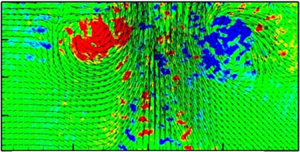Article contents
On the acoustic fountain types and flow induced with focused ultrasound
Published online by Cambridge University Press: 23 December 2020
Abstract

Laboratory experiments are conducted to investigate the mechanism controlling the formation of stable and unstable acoustic fountains at the free surface of a quiescent body of water. Fountains are induced by focused ultrasonic, a new modality that allows for better spatiotemporal control of water flow. Particle image velocimetry was used to characterize the induced flow field in the vicinity of the ultrasonic focal spot. We used two types of ultrasonic transducers with distinct wave frequencies. We examined three fountain formation regimes by varying the pressure level of the transducers, namely weak, intermediate (stable) and highly forced fountains (explosive). Between different regimes, the fountain height underwent a step-change in response to the increase in acoustic pressure. A force estimation obtained from the flow field shows that the magnitude of axial momentum flux is orders of magnitude lower than that of gravity and surface tension, indicating that the dominant driving force for the fountain generation is the acoustic radiation force (Nightingale et al., Ultrasound Med. Biol., vol. 28, 2002, pp. 227–235). We propose a simple model to estimate the shape of a stable fountain; it accounts for the applied acoustic pressure, gravity, surface tension and axial momentum. The model neglects viscous force, which precludes capturing the intermediate fountain surface curvature. However, the model successfully predicts the geometry of the weak and intermediate fountains.
JFM classification
- Type
- JFM Rapids
- Information
- Copyright
- © The Author(s), 2020. Published by Cambridge University Press
References
REFERENCES
- 10
- Cited by



